Yves here. Yes, sports fans, the NRA gives to Dems and it makes them more gun friendly.
By Matthias Lalisse, Department of Linguistics and Cognitive Science, Johns Hopkins University. Originally published at the Institute for New Economic Thinking website
Recent mass shootings in Buffalo, Uvalde, Tulsa, and more have left scores dead from sickening gun violence in just the last few weeks. The wave of injuries and deaths has revived the political debate surrounding America’s uncommonly lax gun laws, raising hopes for reform. Yet we’ve seen cycles of this sort before, with the hopes of victims, their families, and their communities dashed by congressional inaction, with even mild responses like universal background checks extinguished by the constitutionally built-in ease with which minorities can block action in the Senate.
Real reform is not impossible. The 1994 assault weapons ban passed by large margins in both House and Senate, also in the wake of a deadly school shooting. But to carry out such reform, Congress will have to overcome two key factors: the NRA’s entrenched position within the Republican Party, and the ability of the NRA and other interest groups to dismantle the current bicameral Democrat majority by peeling off legislators who take gun lobby money.
The NRA’s ties to the Republicans are well understood, but the second is much less publicized. It turns out that votes on gun control legislation can be predicted with 95% accuracy when using legislators’ campaign finance receipts from the pro-/anti-gun lobbies and the gun industry, with the effect of campaign money statistically significant. In particular, a Democrat who takes any amount of NRA money is about 4 times more likely to cast an anti-gun control vote as those who don’t. The conclusion is inescapable that the gun lobby is powerful not just because it funds nearly every Republican politician, but also because it targets individual Democrats whose votes can be bought or rewarded.
Too Many Guns
As of this writing, more than 200 mass shootings (defined as 4 or more people shot in each such event) have occurred in America in the first half of 2022. Many such events feature shooters who obtained their weapons with nauseating ease. The Uvalde, Texas shooter—18 years of age—used a website to purchase the semi-automatic assault rifle he used to massacre 19 children, picking it up eight days before his rampage. The Tulsa, Oklahoma shooter bought a handgun from a pawn shop and, three days later, an AR-15. The same day that he bought the AR-15, he shot up a hospital.
The supply of guns in America is enough to arm each adult, child, and infant in America with some 50 million guns to spare. We have twice as many guns per person as the runner-up: Yemen. To be sure, part of the reason is cultural. Fully 40% of households have a gun. An American adult is more likely to live in a household with a gun than they are to have a bachelor’s degree. This cultural attachment to the gun is sharply partisan, to such an extent that the absolutist defense of the right to bear arms has become a core interest of the GOP.
In the context of very small partisan margins in the House and Senate, this has led to partisan gridlock on gun legislation, despite the fact that substantial aspects of gun reform are not controversial. Even when moderated by sustained political debate with massive campaign spending on both sides, voters polled in statewide referenda have delivered enhanced background checks with an 86% success rate this century.[1]Yet, federally, even mild national-level reforms like closing background check loopholes are systematically killed in the Senate.
A New Analysis
In a representative democracy, the baseline expectation for policy design should be the majoritarian position: policies that the majority of voters prefer should determine legislative outcomes as a default. Deviations from that state of affairs are what have to be explained. A prima facie plausible explanation is the role of campaign contributors. Elections are expensive, and our campaign finance laws are permissive. To meet the costs of running, politicians accept campaign contributions from those with the means to provide them, which tends to mean the wealthiest. When those contributors are particularly well organized, they can channel those investments into access, votes, and influence.
My recent INET working paper showed that legislators’ individual votes can be predicted with high accuracy using Political Action Committee (PAC) contributions data, and that including such data always led to better predictions than party-level baselines. That analysis,[2] which is based on statistical summaries of campaign finance data and an inventory of about 400,000 individual votes, allows us to demonstrate this effect at scale, but does not differentiate between votes in different policy domains, and does not allow us to link predictive effects back to particular donors or interest groups (see the endnotes and Fig. 6 for discussion).
Here, I narrow the scope by limiting the analysis to gun control measures, including as predictors only PAC contributions from three categories: pro-gun control and anti-gun control ideological PACs, and gun industry PACs (vendors and manufacturers), using PAC category annotations provided by Opensecrets.org. As discussed below, PACS are a subset of all contributions, but the starkness of the evidence here suggests that they are likely reliable as a rough indicator of preferences.
Method. I examined 14 votes—7 in the House and 7 in the Senate—identified as key national gun policy votes by VoteSmart. Every item in VoteSmart’s list was included if it was primarily about gun policy[3] and could be unambiguously interpreted as pro- or anti-gun control.[4] To get numerical summaries of bill content, official summaries of each bill/amendment assembled from congress.gov were embedded using a neural network[5] and then projected into 5-dimensional text feature vectors using principal component analysis. The merits of this feature generation approach to text data are discussed in (Lalisse 2022).
The final dataset[6] includes five bills/amendments strengthening background checks, one that weakened them, a semiautomatic assault weapons ban, a ban on high-capacity magazines, two bills nationalizing state-level concealed carry laws via interstate reciprocity, a bill guaranteeing the right of “mentally incompetent” veterans to buy a gun, and a pair of bills blocking certain gun laws in the District of Columbia—including the “Defend Our Capital Act of 2015”, which would have legalized concealed carry for visitors to the District of Columbia, and might in retrospect have been called the “Make Insurrection Deadlier Act.”
The bills were manually assessed for directionality (pro-/anti-gun control) by inspection. For the main analysis, the roll calls (legislator-by-legislator voting records) were retrieved from the VoteView research database. The resulting table of votes (N=3720) was split into 10 cross-validation partitions, holding out 10% of legislators at each fold. The baseline is the party-line vote: a held-out legislator votes how the majority of their party voted in the training fold. The main predictors of interest are the summed contributions to a legislator from each of 22 gun-related PACs from 2008 to 2020.[7] If gun money is informative over and above party affiliation, we predict higher accuracy for models including the gun PAC features, relative to the baselines.
Results. Table 1 displays results for an array of models combining the following predictive features:
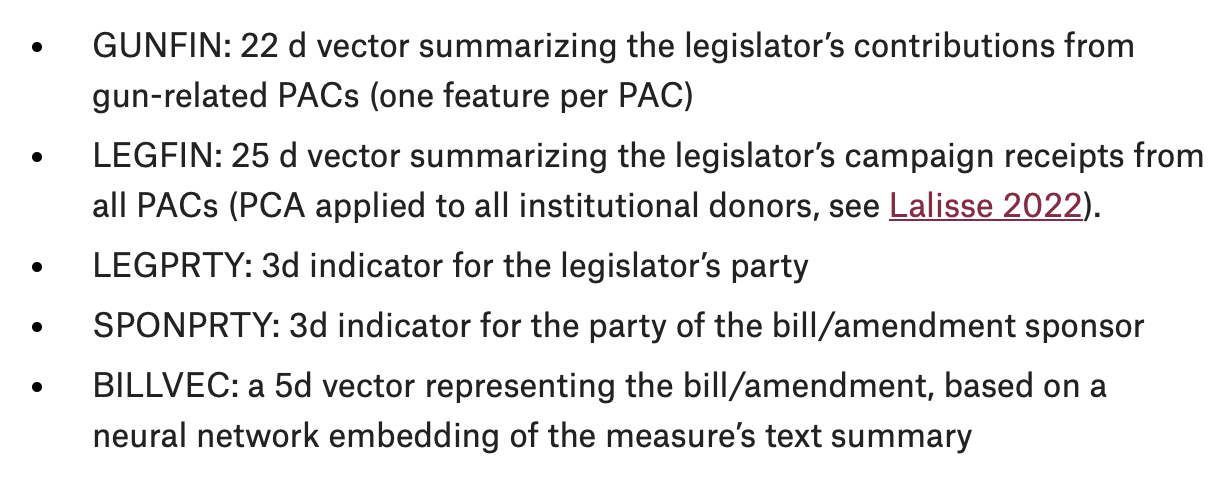
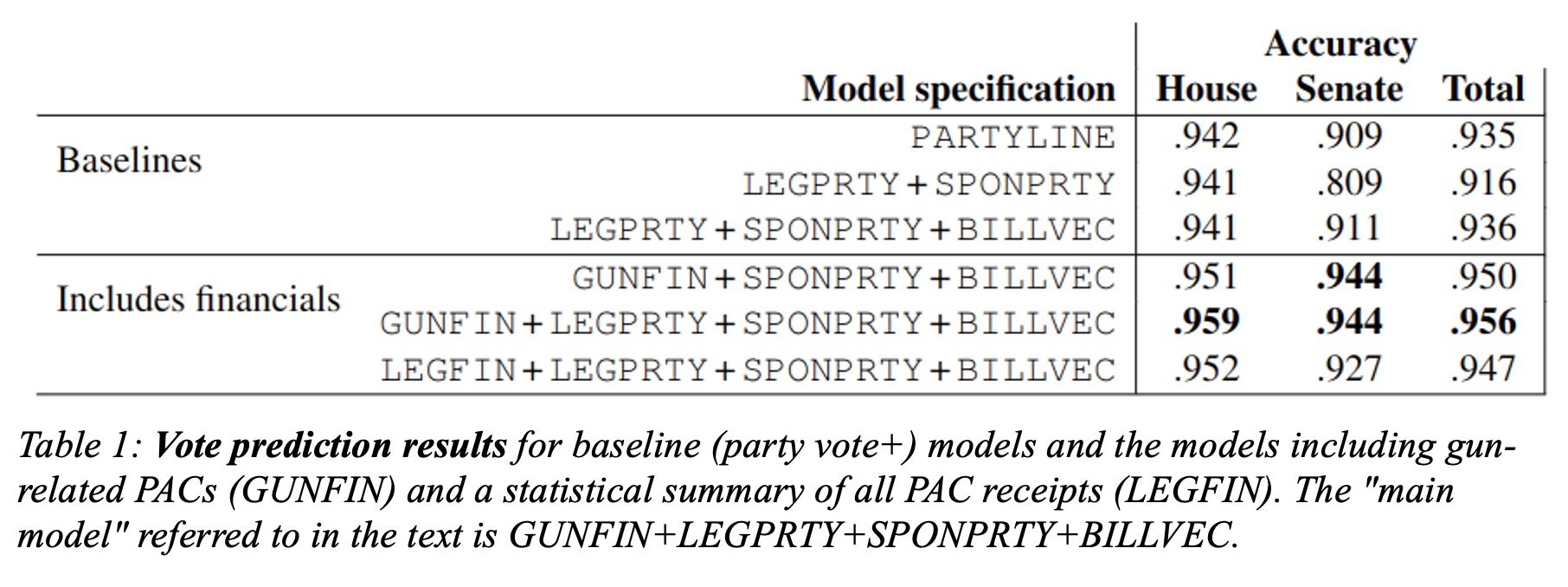
The main model performed best, with a 3.5% improvement in the Senate and a 1.7% improvement in the House, which amounts to 3 additional Senate votes and about 7 additional House votes predicted per roll call, over and above the party-line vote. This result is significant at the ɑ=.001 level, as confirmed by a permutation-based protocol.[8] Furthermore, GUNFIN outperforms LEGFIN (the all-PAC summary vector), which itself outperforms the baselines, validating the earlier approach while also reinforcing the hypothesis-driven approach taken in the current analysis.
Assessing directionality. GUNFIN groups together information from three broadly-defined interest groups:[9] (a) pro-gun ideological groups, (b) anti-gun ideological groups, and (c) the gun business (e.g. Smith & Wesson). This typology is misleading. Yes, it is surely the case that there is no organized industrial interest backing the anti-gun movement.[10]Congressional campaign spending by organized interest groups seeking gun regulation is basically a new phenomenon.[11]Anti-gun spending was negligible until the 2014 election cycle, when Gabby Giffords—following the tragedies of Sandy Hook and her own attempted assassination—formed Americans for Responsible Solutions as a counterweight to the NRA (see Fig. 2). Direct campaign spending by gun industry actors does not show up in most conventional tabulations of campaign spending, which do not analyze individual contributions by executives (see Ferguson et. al. 2020 for discussion, and solutions, in an analysis of the banking sector).[12]
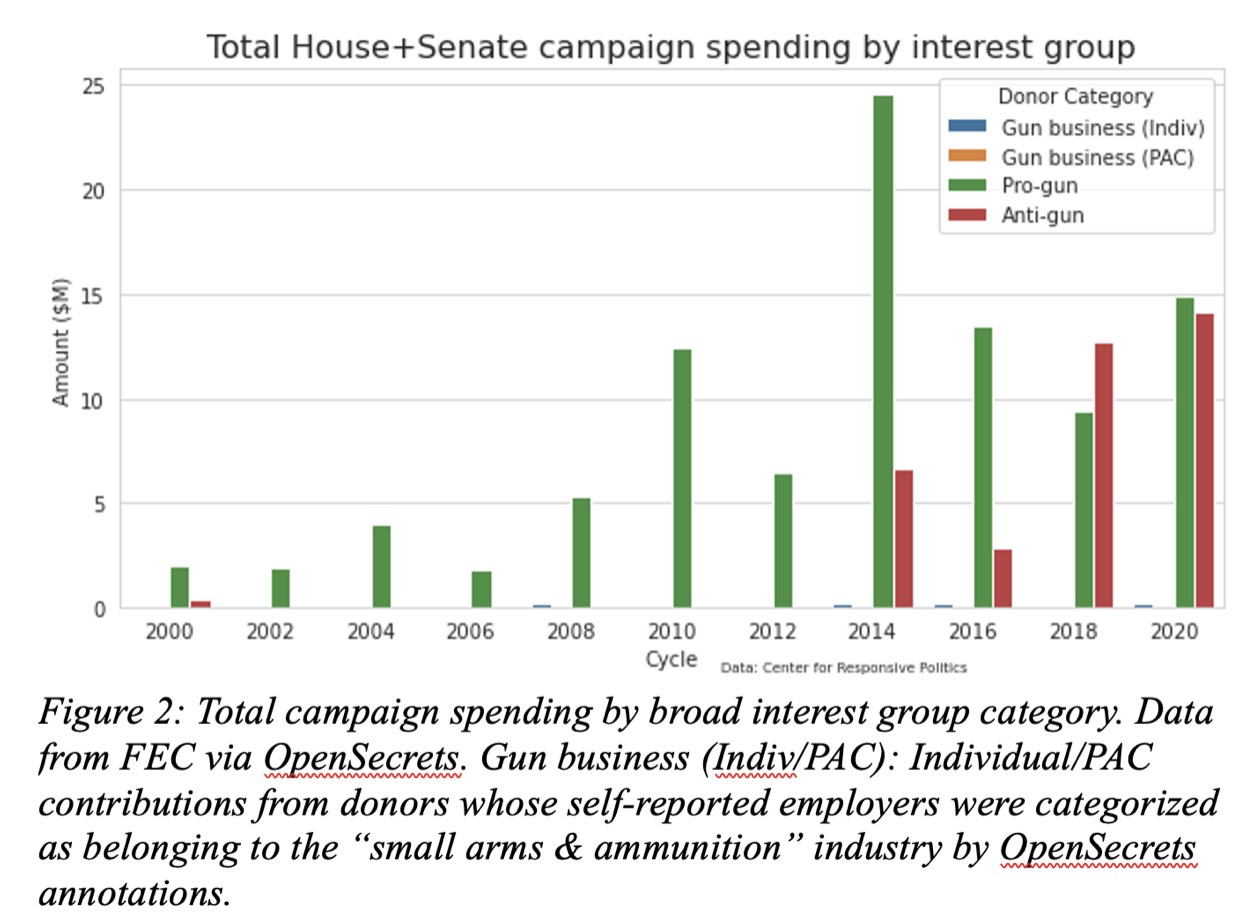
However, to view the NRA as an “ideological PAC” in contrast to gun business PACs is surely not correct. The NRA brands itself as a grassroots civil rights organization, but its political activities would be impossible in the absence of backing from the gun industry, whether via direct contributions or through the vast network of weapon vendors and manufacturers that staff and sponsor NRA events, without which a politically mobilized consumer culture oriented around the gun is fairly hard to imagine. It is thus more appropriate to say that the gun lobby operates as a semi-autonomous cultural organization whose primary purpose is to amplify the interests of its industrial base by transforming that base into an ideology.
These caveats aside, the predictions for each category are clear: pro-gun (“ideological”) and gun industry PACs should predict anti-gun control votes, and anti-gun (“ideological”) contributions should predict votes in favor of more gun control, particularly when crossing party lines (pro-gun to Democrat, anti-gun to Republican), with the following subtlety: that above-average contributions to a legislator within the interest group-aligned party (e.g. large NRA contributions to Republicans) may in fact be directed at legislators who need incentives to remain in the fold. This is essentially the relationship we observe (Fig. 3).
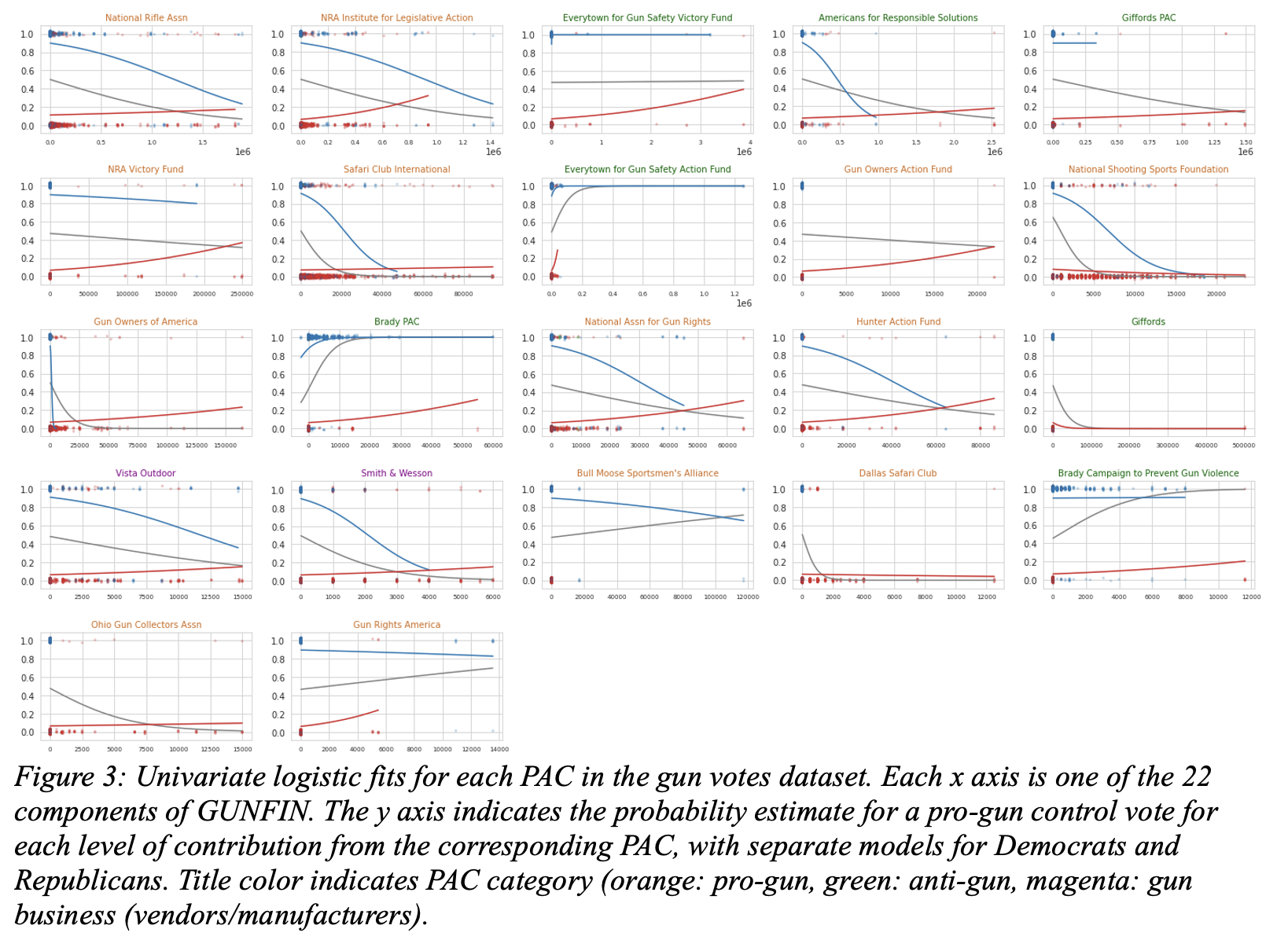
The additional predictive power of campaign finance in relation to legislators’ votes is significant both statistically and also in terms of its practical effects. Part of the reason the NRA holds sway in D.C. has to do with its influence on the Republican Party. That influence flows through contributions to party PACs, the campaigns of party leaders (GOP whip Steve Scalise is the largest individual recipient), as well as recurring contributions, spread so widely through the party that the interest group becomes a sustainer for most members (only 2% (11) of the Republican politicians in the gun votes dataset did not receive any NRA money).
An interest group thus embedded in the party apparatus can determine legislative priorities, affect the leadership’s commitment to whipping votes, influence the selection of party-endorsed candidates, and steer the party PACs’ contribution profiles (which candidates the party supports, and by how much). This sort of party control wielded by the NRA explains events like NY Congressman Chris Jacobs’ recent single-issue purging from the GOP after he endorsed an assault weapons ban—expulsion not by the voters, but by the party.
The broad architecture of this aspect of political money was described by Thomas Ferguson’s Golden Rule: parties are not vote-maximizers, but rather the manifestation of “blocs of major investors who coalesce to advance candidates representing their interests.” In line with this account, we are able to basically swap campaign finance data for the party and obtain better predictions than those we get from the party-line vote. GUNFIN is an effective proxy for party.
But it is also more than a proxy for the party. The true impact of targeted campaign finance is felt when a vote is within the penumbra of a key threshold (usually the 50% majority, but sometimes the 3/5ths filibuster threshold), in which case a sufficiently agile interest group with a bag of campaign recipients can influence those clients in the preferred direction.
The balance of power between the parties in recent Congresses has been increasingly narrow. The current climate of intense partisanship and a narrow party division are very much to the strategic advantage of businesses and other interest groups seeking to determine policy outcomes, since it means being able to count on partisan gridlock as the default scenario, with individual votes tilted through targeted mobilization of legislative assets. Without campaign finance reform that curbs maneuvers of this sort, policy-making on guns and other issues may well turn on such dynamics.
Money Matters
We are all familiar with the following routine. A journalist reports on a large contribution from some interest group at odds with a politician’s stated values and seeks comment from the recipient. The cookie-cutter response given by a Henry Cuellar staffer—his boss caught red-handed with a $6,950 check from the NRA—may as well stand in for them all: “Contributions of any size have never and will never influence his policy positions.”
Who can say what was in Henry Cuellar’s heart when he voted to federalize Texan gun law? Or when he voted that “mentally incompetent” veterans who’ve had run-ins with the law—like the Thousand Oaks shooter—should be able to buy guns unimpeded? When he voted twice to rob D.C. voters of their will regarding the proliferation of guns on their streets? Or when he voted, after Uvalde and unlike every other Texas Democrat, not to ban high-capacity ammo clips that can be used to kill ten at a time?
Who can say? Yet, the following calculation may prove useful as an instrument to any voter faced with the choice between two politicians, each avowed to be clean of heart, with one taking NRA money and one who does not. In my sample, a vote from a Democrat who has taken any amount of NRA money (N=219) is about 4 times more likely to be a pro-gun vote. A vote from a Democrat who took $10,000 or more in NRA money (N=69) is 10 times more likely to be pro-gun than one from a Democrat who took none (N=189).
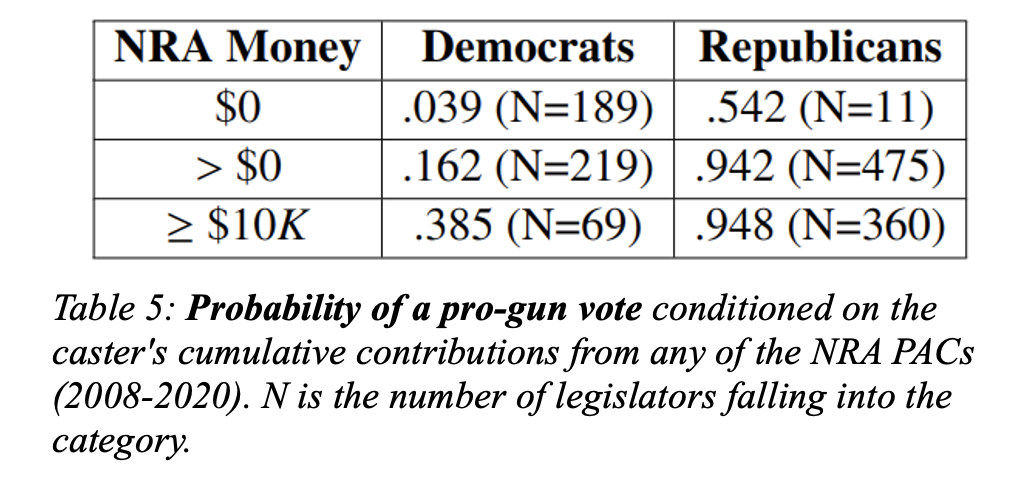
The facts speak plainly: if you want to know how your congressional representative will vote, look beyond the party label and follow the money.
Notes
[1] The National Conference of State Legislators’ ballot measure database records 7 such referenda since 2000—one each in California (2016), Colorado (2000), Maine (2016), Nevada (2016), and Oregon (2000), and two in Washington (2014 and 2018)—with Maine’s the only one that did not obtain a majority.
[2] The analysis in Lalisse 2022 did not differentiate between votes in different policy domains, and it also made use of statistical techniques that summarize highly correlated donation profiles into aggregate features (the output of principal component analysis) that do not easily trace back to individual contributors’ impact. The method also suffers from unmeasured directionality: a vote of “Yea” on a bill that is about “gun control” depends not just on the topic of the bill, but also whether the bill is pro- or anti-gun control (among other factors). Machine learning models of the sort used within this paradigm are able to estimate nonlinear decision boundaries that take into account interactions between features, e.g. by solving analogs to the XOR problem (see Fig. 6)—and indeed, models like this are unavoidable in order to capture such appropriately messy generalizations as “a Republican will never vote for an assault weapons ban, especially if that Republican takes NRA money and received their endorsement, except if that Republican is independently wealthy and represents an area recently afflicted by a mass shooting,” a generalization that would account for GOP Congressman Chris Jacobs’ recent change-of-stance on assault weapons. An analysis of this sort, which does not reduce to cumulative linear effects, can be captured in the coefficients of an appropriate nonlinear model. The resulting complexity, though, means that directionality becomes hard to assess.
[3] Excluding, for instance, the March 2021 reauthorization of the Violence Against Women Act, a 311-page bill that included restrictions on gun ownership for those convicted of stalking or intimate partner violence alongside dozens of other significant measures unrelated to gun control.
[4] This included a pair of House and Senate amendments directed at gun laws in the District of Columbia, as there was clear directionality to those measures—e.g. the Defend Our Capital Act (S Amdt 2915), which would have enforced reciprocity of state concealed carry laws specifically within D.C., mirroring national-level reciprocity proposals. The clear directionality criterion excluded a series of 2016 Senate amendments imposing varying degrees of restrictions on gun purchases by suspected terrorists, as well as a bill making federal lands available for hunting.
[5] Beltagy, I., Peters, M., & Cohan, A.. (2020). Longformer: The Long-Document Transformer.
[6] The final sample includes 6 House bills 1 amendment. All 7 Senate votes were on amendments (the Senate has not held a vote on a standalone gun control bill since 2005, when it voted bipartisanly to immunize gun manufacturers from prosecution for shootings using their products). 2 cloture votes (votes to end a filibuster) were included, with votes of “Yea” interpreted as being in favor of the underlying measure.
[7] All gun-related PACs were included if they contributed at least $50,000 in the target period.
[8] In this procedure, each legislator was randomly reassigned to another legislator’s GUNFIN vector, with the model then re-trained and evaluated with shuffled campaign finance profiles. This was repeated 1,000 times. Parameters of the permutation distribution: μ(accuracy)=.927 , σ(accuracy)=.002.
[9] For this analysis, we use the typology developed by Opensecrets.org.
[10] Though it is also true that the gun reform movement is woven in with billionaire Michael Bloomberg’s ambitions to solidify his stance within the political establishment.
[11] See Fig. 2, though see also Opensecrets’s review for historical spending on lobbying by anti-gun groups, which is more substantial, but still dwarfed by pro-gun spending.
[12] The financial data used in this study is limited in many respects, though I believe PAC data has some advantages also. While they can be straightforwardly and accurately classified into broad interest group categories (with the sorts of caveats mentioned in the text), they only account for about a quarter to a third of direct campaign contributions, while individual contributions data are famously incomplete in the FEC listings. Grouping together contributions from individuals with the same employer requires labor-intensive scripting for employer name normalization and various other operations. Furthermore, the mapping from individual to employers is sometimes one-to-many. Take Elon Musk, (former) CEO of companies in financial services, space, biotech, automotive, batteries, highway tunnel infrastructure, and a variety of other industries. Other forms of money are typically left out of most tabulations. See the analysis in Ferguson et. al. 2020 for discussion, and solutions, in an analysis of the banking sector.


Idk, I think an interventional study is needed to support such a conclusion. It sounds to me that the NRA supports pro-gun legislators. That doesn’t necessarily mean it creates them. Cuellar is in TX which is a gundamentalist state, and he is also a general purpose jerk. Still, this is yet more shame on Pelosj for supporting him over Cisneros. BTW any update on that primary?
Recount underway today, supposed to be finished by 5pm.. Livestream here.
The “gun owners are largely Republican voters” idea has being bent over the last few years, since just before Obama got office, due to fear of civil unrest. Lots of first time firearm sales. Hopefully, lots of gun safety training and basic proficiency course attendance too.
Some time ago, Slavoj Zizek made an insightful observation concerning Donald Rumsfeld’s infamous formulations: the known-knowns (the things we know we know); the unknown-unknowns (the things that we don’t know we don’t know); and the known-unknowns (the things we know we don’t know). He correctly noticed that there was one missing, the unknown-knowns, i.e., the things we don’t know we know.
In this instance, I feel that the article helped to illuminate the thing we all knew but couldn’t prove.
Not really: a widely known truism in politics has been that interests know who their friends and back them, not that they create their “friends” by backing them. This is just showing that the gun interests know who their friends are, that is all.
We have this faith that politicians are being “bought.”. I don’t think anyone can show a single politician who changed his or her stance on a well known issue because they were promised support (much less money). I will allow for possibility of influence on obscure issues that very few ppl know or care about, but stuff like guns ain’t it
Another “res ipsa loquitur.”
Maybe at this time the grift is so obvious, and the credibility of the Uniparty is so debased, and they collectively have given us mopes the big middle finger so plainly and repeatedly (even unto idiot dresses on AOC and Pelosi and her Kente cloth wrappers, that the Rule of Chutzpah applies — Congress can just go ahead and start selling “naming rights,” a pre-eminent “free market function,” and do public labeling of their persons. Would be some funny debates over the sizing and placement of brand stickers… I bet they could get a deal from the same outfit that sells the nice light jackets to the people on the floors of the exchanges… with tails, for the critters that run out of space to put owners’ labels.
In regard to the “Assault Rifle Ban” that lasted a decade, it had no effect on violent crime for the simple reason that violent criminals are not law abiding.
And I’m really effing tired of hearing that I can’t possibly support a Woman’s right to choose and also believe that the 2nd Amendment grants an individual right to keep and bear arms.
I’ve actually heard “You own guns, you must be a racist”.
I’m supposed to trust the Government that has tortured Julian Assange for years for committing the heinous crime of printing the truth about US Government War Crimes?
Of course I should trust the FBI of Kevin Clinesmith, Peter Strzok, Andrew McCabe and the rest…And Gosh, the Police are always there to protect us in places like Homan Square, anywhere the LA County Sherriff’s department patrols,Minneapolis, Uvalde…
And if you are Black or Gay you should be celebrating the end of Racism and Homophobia and not worrying about your safety.
Okey-Dokey
I’m in line with having guns, but what, exactly, will you be doing with yours to have any, even tiny marginal, effect on FBI corruption and abuse, and freeing Assange, and making sure all Homan Squares are shuttered and their operatives punished, and protecting woman ness or Blackness or other-than-heterosexuality? I think guns are cool, but have no illusions that a “well-armed citizenry” does jack-sh!t to foster democracy or affect the arc of repressive looting. You going to shoot it out with cops who stop you for a busted taillight or want to civil-forfeit your vehicle or bank account?
I also like female-flavor gun-themed soft porn — shapely, barely dressed ladies sporting fully kitted-out ARs, with pretty pink Glocks on each hip, or gals in mini kinis gettin’ it on at the range, shooting M-60s and mini guns and antitank rifles and .50-cal sniper rifles. Now that’s the right to keep and bare arms, and other stuff, that I can get behind…
My fave rifle is the Ruger Mini-14, and a Taurus 9mm pistol… so much to choose from, none of it likely to make the smallest difference in the direction of the political economy. More likely to get me shot in a home invasion, or otherwise used for other than expected purpose… given reality.
I’m sorry, but pink Glocks are an abomination. ;-)
My bro-in-law told me a joke: “Why do Palestinians throw rocks at Israeli soldiers? Because they don’t have AK-47s!”
He then proudly told me his daughter had just bought an AK-47.
“Good! When the gubmint fires a Javelin at her, she can throw her AK-47 at it.”
This article, while informative, seems to missing the jungle for the trees.
It does not matter, if the doer is Republican or Democratic because the process is the same. The Overparty get an advantage into dividing most everyone into two actually fairly small, existing extremes, and then saying if your beliefs and actions deviate in any way from one of the extremes, you must belong to the other one; you are heretic and apostate, therefore, you are Cancelled and sent to the Outer Darkness! (Republicans cancel people too by calling them RINOs and exiling them from the movement.)
The Blue and the Red True Believers both get to make me out to be evil and then ignore me. Since I am an old school supporter of LGBT rights, a supper of the Second Amendment, a supporter of free national healthcare, a classical liberal, a socialist, a Constitutionalist, and…
According to some, I must be an authoritarian or totalitarian, racist, bigoted, transphobic, neoliberal, tankie and Putin stodge, which makes not sense, but using the plug and play method of political identification many roll on, that is who I am.
A great way to peel off voters; never do anything to fix the supporting structures because we are forced to look at some boards in the wall.
Actually the NRA-ILA gets a lot of heat for supporting Democrats on a single issue, in particular in incumbent Dem vs Rep contest where the R is probably aligned the same way on the issue. But real RKBA-types consider NRA a sell-out. They more likely support GOA.
Cause and effect problem here. Sample:
The votes in Congress supporting abortion rights are almost perfectly predicted by abortion rights campaign contibutions.
Chages over time might be useful to look at. But this article proves little.